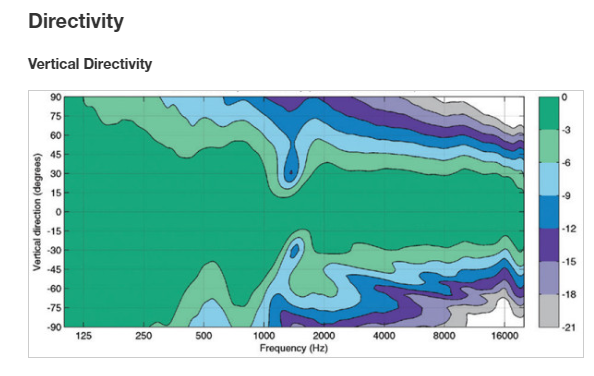happens on the vertical axis....non the less.
Thats what you expect for all speakers in this kind of configuration with a crossover that high.
Wavelength at 1.7k is 20cm so we are trying to get the 2nd source within 5 cm Center to center to avoid this issue.
most studio monitors suffer from this issue. Genelec just isn't hiding it at all
Am I the only one noticing that you can't get perfect signal unless you are within 15 degrees of center....all that effort and it still beams. The beaminghappens on the vertical axis....non the less.
I wrote this article that explains it: What Causes Off-Axis Nulls?
It's something that's common to nearly all two-way loudspeakers with a waveguide. It's caused by the center-to-center spacing.
I will then build the one on the right. But still I wonder, since these are both from an email message that is dated November 2012. Is it possible that there was some other change back then? Or already some development with DE500.
There was no development of an Abbey with a DE500, none were ever built. But there were always small changes to the crossover design for a myriad of reasons, but they all worked basically the same.
Thanks Patrick. I'm realizing information that I should of known already, and probably had this explained once already...I feel like the cross over, group delay, and phase all paint a picture in the polar, one that I cannot simulate with xDir.
Of the crossovers, one has twice 0.5 mH inductor, another has twice 0.45 mH inductor. Do you think I'd be fine with 0.47 mH ones in either case?
Should I prefer 0.83 or 0.36 ohm series resistance for those inductors? Is lower always better here?
Also, instead of ordering parts so that I can build either one of the crossovers, I think I should settle for one or the other. If those are equal in performance, I think I will see which parts are more easily and readibly available. I'm going to order these from TME with some other stuff for a few unrelated projects.
Should I prefer 0.83 or 0.36 ohm series resistance for those inductors? Is lower always better here?
Also, instead of ordering parts so that I can build either one of the crossovers, I think I should settle for one or the other. If those are equal in performance, I think I will see which parts are more easily and readibly available. I'm going to order these from TME with some other stuff for a few unrelated projects.
Getting ready to order the parts from TME. I assume it's not good to use "ordinary" resistors or capacitors, so I'll order what they call generally "audio grade" stuff.
A 2 mH coil does not exist, therefore I go with the crossover that has a 1.5 mH one. Those are available. I could find all the capacitor values except one. I make 3 µF capacitors out of two 1.5 µF (instead of, say 1.2 + 1.8). I have a capacitance meter for matching them. But does it matter otherwise?
Now only thing left is a 6 Ω resistor. If I combine one 2.7 Ω and one 3.3 Ω with half the power rating, I think I'll be good. Do metal film versus wire wound ever make a difference here?
A 2 mH coil does not exist, therefore I go with the crossover that has a 1.5 mH one. Those are available. I could find all the capacitor values except one. I make 3 µF capacitors out of two 1.5 µF (instead of, say 1.2 + 1.8). I have a capacitance meter for matching them. But does it matter otherwise?
Now only thing left is a 6 Ω resistor. If I combine one 2.7 Ω and one 3.3 Ω with half the power rating, I think I'll be good. Do metal film versus wire wound ever make a difference here?
Parallel capacitors work fine. But, two resistors in series will not double the power rating of any one, but it does lower the current in each, meaning that less power is dissipated. I tend to avoid "audio grade" parts as mostly scams, but you do have to avoid electrolytic caps as they can be problematic.
- Home
- Loudspeakers
- Multi-Way
- Matt's Gedlee Summa Abbey Kit Build